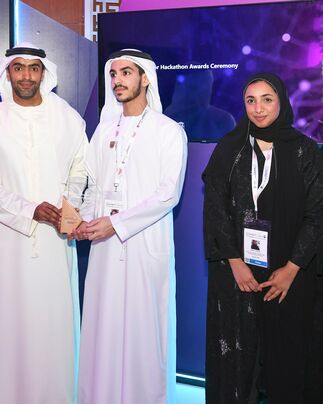The Environment Agency – Abu Dhabi (EAD) has launched the first project of its kind in the region to electronically link (e-link) the entire Stacks Automated Monitoring System (AMS) in the Industrial, Energy and Oil and Gas Sectors across Abu Dhabi directly to its emissions monitoring system. The new e-linking system is designed to connect up to 500 stacks, enabling real-time data collection.
Her Excellency Dr Shaikha Salem Al Dhaheri, Secretary General of EAD, said: “As part of our continuous efforts to ensure we are enhancing air quality in the emirate of Abu Dhabi for better public health, we are e-linking all air emissions monitoring systems in the Industrial, Energy and Oil and Gas Sectors directly to us at EAD, allowing accurate data to be used in making appropriate decisions.
“We are always looking to use the latest and most effective technologies to monitor emissions and its limits, where we developed a system that adopt artificial intelligence to predict air quality through an early alert system, to take proactive measures when facilities exceed the emission limits of permissible standards, and to cooperate with them in developing appropriate plans and solutions, ensuring their compliance with the national air pollution protection standards. The collected information will also help us to validate the effectiveness of the procedures implemented in improving the operational practices in the different sectors. Currently, 53 stacks from the sectors have been successfully linked to the EAD system.”
His Excellency Eng Ahmed Mohamed Al Rumaithi, Undersecretary of the Abu Dhabi Department of Energy (DoE), said: “We are proud to see the linking project launched by the Environment Agency – Abu Dhabi. This is a significant milestone in our journey towards environmental sustainability.
“The e-linking project will allow us to collect real-time data related to emissions across the emirate of Abu Dhabi. This will give us a much better understanding of emissions levels and will enable us to take targeted actions and develop effective solutions to reduce them.”
His Excellency Al Rumaithi underlined that DoE has played an important role in this pioneering project of linking our CEMS system to EAD and said: “We have continued to work closely with the agency to ensure that the project is a success. The e-linking project is a vital step in supporting Abu Dhabi Government’s strategies for environmental sustainability. It will help us to meet our CO2 emissions reduction targets and will also enable us to improve air quality in the emirate.
“The DoE is committed to working with EAD and other strategic partners to build on this success. Continued collaboration between government agencies, private organisations and the public is the key to achieving environmental sustainability goals. Together, we can accelerate the development of Abu Dhabi’s sustainable future."
Abdullah Al Khemeiri, Executive Managing Director at Arabian Power Company, said: “As we focus on emissions and combating climate change, the focus towards reducing emissions and improving sustainability practices is more important than ever. With this in mind, the Umm Al Nar, Independent Water and Power Project, has deployed this CEMS technology since 2016, and we have been sharing emissions data with the EAD, which demonstrates our plant's commitment to supporting the government's environmental and sustainability initiatives. Having access to this data and the continuous monitoring of our emissions allows us to identify opportunities for further improvement. This continuous emission monitoring supports full visibility of plant emissions and determines and highlights any abnormality in real time, it supports process control and assists with proactive plant management. Having access to real-time data is imperative for operators, and working with EAD allows us to support the greater efforts towards decarbonisation in the Emirate of Abu Dhabi and provides more transparency when it comes to emission standards and reporting in the UAE.”
Engineer Saeed Ghumran Al Remeithi, Group CEO of Emirates Steel Arkan, said: “Emirates Steel Arkan stands as a leading force in decarbonising the steel and building materials industry at scale and further supports the nation’s strategic initiative to realise net zero by 2050. Through our participation in the e-linking project with EAD, we are proudly driving significant efforts to monitor and reduce our carbon emissions and lead the transition towards a greener future.”
Salman Dawood Abdulla, Executive Vice President ESG and Sustainability at Emirates Global Aluminium, said: “The innovative e-linking system will create a symbiotic relationship with EAD and also will empower stakeholders towards our shared objective of preserving and improving our environment. This advanced system not only streamlines emission data collection and reporting but also supports the formation of future policies and regulations, ultimately driving our pursuit of a comprehensive understanding of Abu Dhabi's air quality.”
The system will enable key stakeholders and EAD to prepare and download customised reports for a quick overview or periodic reports such as monthly, quarterly and annual for permit compliance. This will decrease the cost and time required to prepare and publish reports and learn about the overall air quality in the emirate.
As for stacks in facilities that do not require the installation of AMS devices, the operators of these licensed facilities will be able to submit data through a specialised electronic portal in order to integrate their emissions information into a central database that covers all stacks in Abu Dhabi.
The central database also integrates with other initiatives such as atmospheric modelling and national inventory reporting, which will subsequently support achieving the environmental goals set for the project.
The database also features an alert system which emails facilities and EAD air quality specialists when emissions limits are exceeded. This will help to promote the direct collaboration between EAD and the facility to mitigate air emissions directly from the source.
Based on global best practices for emissions monitoring, the agency developed the project after reviewing the international best practices to ensure that the system aligns with other similar pioneering initiatives to improve the process of collecting emissions monitoring data, and ensure its quality.











